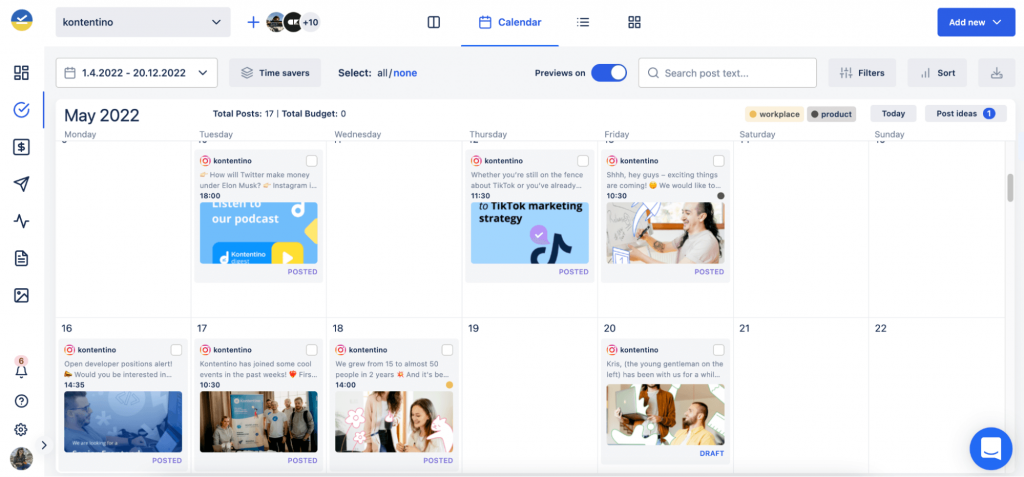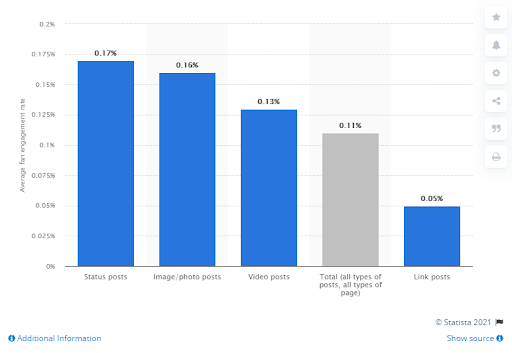Many social media managers spend their time monitoring social media analytics but fail to track the KPIs that REALLY matter.
In the midst of so many different numbers, statistics, and metrics, it’s hard to pick just a few social media KPIs to focus on.
That’s understandable. But, as always, we are here to help.
In today’s post, we’re going to break down how to choose social media KPIs and why it’s important to do so. Furthermore, we’ll show you 17 social media metrics worth keeping an eye on.
What are social media KPIs?
Social media KPIs are key performance indicators that measure the success of social media marketing. They can be used to track different aspects from sentiment analysis to follower growth and engagement rates. Bear with us, we’ll reveal them all soon!
For example, if you’re trying to measure Facebook engagement, then you may want to look at how many people have liked or commented on your posts over time. A social media KPI can also be used to analyze the interaction rate between followers and posts. In light of your results, you may draw conclusions, improve performance, or… simply congratulate yourself – because why not?
For any company that wishes to evaluate its social media performance and benchmark itself against competitors in order to continuously improve, social media KPIs are essential.
Why are social media KPIs so important?
There are quite a few reasons why it is worth tracking social media KPIs.
Social media KPIs reveal your social media health
Having a look at the KPIs of your social channels can give you a great perspective on how they are performing. Additionally, doing so can identify areas for improvement and lead to new ideas about how social media channels can be used to achieve the goals outlined in your strategy.
Social media KPIs go hand in hand with ROI
By evaluating social media KPIs, you will be able to calculate the ROI of your social media marketing campaigns. This way, you’ll be able to make better decisions about where to allocate or reduce funds from your marketing budget.
Social media KPIs impact the rest of your strategy
In fact, social media metrics can have a significant impact on several decisions. Here are just a few handy examples:
- Which social media platforms should you focus on?
- Where should your content be distributed?
- What type of content should be created?
- When is the best time to post?
- How to divide the advertising budget?
Although social media may be just one component of your marketing mix, with the right social media KPIs you can take your brand places and achieve your goals. Create your own content calendar and plan your publications across different social media platforms with social media content calendar.

How to pick the right social media KPIs in the best way?
Understand the specifics of social media platforms
The first step is understanding the fundamentals of social media. A social network, or social media platform, gives people the opportunity to discuss brands and products while being exposed to advertisements from those same companies. Marketers and content creators need to understand the needs, desires, and behavior of their own audiences on specific social networks – for example, what works on Facebook might not work on Instagram. It’s therefore important that business owners who use social media as part of their marketing mix have a strategy tailored specifically for them by a person who knows how to operate on those social channels. The right set of KPIs will depend on such a strategy.
Evaluate what you have done on social media so far
Check what you’ve done.

By analysing your content, you can learn how it performs, what channels are successful, and who is seeing your message versus who is not. Such information helps marketers make other decisions about strategy, such as where to spend future ad budgets and how to adjust social messaging to fit various situations.
Social marketers can use this method to measure their success across different social networks and figure out what they need to improve on. It’s important that this process of self-evaluation does not end there, because it will only become more complex as social media platforms change constantly and new ones pop up every day.
Social engagement, social referral traffic, and social following are common KPIs to track on social media. Other social media metrics may be more specific to a company’s industry or goals, but these three give a quick overview of how a social marketing campaign is performing at any given moment. Stay consistent and organize your workflow with social media automation tools.
Choose 3-5 social media KPIs to focus on
Social media marketers may find it useful to keep an eye on different social media KPIs. Doing so will allow them to monitor trends and changes in the social landscape, whilst staying on top of any problems that arise from one social channel or another.
To prevent overwhelming the system, pick just a couple of social media KPIs at the beginning. This gives social marketers a chance to determine whether or not the KPIs they are focusing on are in line with their social media marketing strategy, as well as how those numbers correlate with data from other social networks.
Make it SMART, for real
You should follow a SMART rule for each social media KPI.
- Specific: such a social media KPI should be outlined for each aspect of a company’s social media strategy and goals.
- Measurable: social media KPIs need to have measurable data points that are accessible via at least one social media platform.
- Attainable: social media KPIs must be realistic for the time period being considered or the individual circumstances.
- Relevant: social media KPIs should provide meaningful feedback about your particular strategy so that they are not just numbers on a spreadsheet, but also help you make smarter decisions about how to spend money moving forward.
- Time-bound: clearly setting a deadline is crucial for social marketers as doing so will help them gauge their progress by seeing how much has already been achieved.
Decide how to analyze and review your social media KPIs
You need to further analyze and evaluate your social media KPIs after they’ve been set up. What is the best way to go about it? The answer to this question depends on the social media KPIs that you are tracking.
Social engagement can be analyzed by seeing which posts on social media get more likes, as this is a good indication of what your audience wants. For referral traffic, it’s helpful to understand if visitors come from Facebook, Twitter, or another channel? As a result, it will be possible to determine whether or not followers across different networks overlap so that they can be targeted accordingly.
One way to assess progress in social following (or lack thereof) is to look at daily changes over time, such as the number of followers growing or declining, and the number of people who follow back. A social marketer should analyze any change and determine how it happened and whether they can respond to it.
It’s important to remember that social media KPIs have to be reviewed on a regular basis, not just once after some event or at the end of a certain time period. This way, you will have access to data in real-time rather than waiting for reports, which means course corrections can be made more easily along the way.
Looks like you’re all set? Check out some of the specific social media KPIs that you can use in your strategy.
What social media metrics to pick as your KPIs?
#1 Follower count / audience growth rate
We start on a controversial note. It is often said that follower count is a vanity metric, yet audience growth rate can actually reveal a lot.
If your social media following has been decreasing for some reason, it’s worth looking into the cause. You can also do this the other way around – if you notice any spikes in the number of followers, investigate why. You can measure the pace at which you are developing your social media profiles by looking at the audience growth rate. You may wish to consider making some changes to your social media strategy if you notice that the audience growth rate is worryingly low, especially compared to your competitors.
#2 Reach on social media
Among social media KPIs, reach is one that social media managers, and marketers in general, are always on the lookout for. This KPI measures the number of people you’ve reached on social media – for some, it’s just another vanity metric, but it does have some practical applications too. However, it is crucial not only to measure reach per see but specifically reach within your target group. Reaching a lot of people from outside your target group will not yield measurable results. Rather than aiming for everyone, it is better to narrow your audience down and ensure that only those who are interested in your content are targeted.

#3 Social media post reach
In the above section, we discussed social media reach overall. The reach of a single post can also be a challenging KPI in social media!
It measures the percentage of social posts which were seen by users, and it’s a quick way to see if you are getting your social media KPIs right in terms of frequency or timing.
Any company that has multiple profiles across various platforms such as Facebook, Twitter, Instagram, or etc. should be able to identify what type of content is most successful on their social profiles in order to target every platform with the same content (or not). Ultimately, people tend to use different channels at different times for completely different purposes, in which case it makes no sense to target them with the same message at the same time. Let’s say an advertising agency knows from experience that Facebook users are fond of photos, then they should add more images or links to stories rather than videos. A particular post’s reach and the overall reach may increase as a result.
This is one of the social media KPIs that can let you know if your strategy is working, so it’s worth monitoring the reach of your posts across all platforms.
#4 Impressions
Some people mistake impressions with reach. While they are similar, they cannot be taken as the same social media KPI.
Social media impressions refer to how many times a social media post is seen. Social media KPIs like this can provide a good indication of how many people see your posts and can be used to compare your performance against competitors who have similar numbers of followers in order to determine engagement levels. As opposed to reach, impressions are responsible for counting the numbers of actual views of your content, which is often multiple times from the same person.
When you generate a lot of impressions, yet not that many reactions or clicks, it may mean that your creatives wore out in the eyes of your social media audience and are not attractive any longer. It is therefore essential to keep an eye on this KPI when it comes to social media strategy. Stay consistent with these social media scheduling tools.
#5 Clicks/Traffic
Some social media profiles exist primarily to drive traffic to external websites such as online stores. The actual traffic generated on social media is therefore one of the most important KPIs.
Of course, it takes time for someone to click on a post and visit the linked website after they have seen it in their newsfeed or timeline. It is best if the time between clicking on an ad and visiting the page is as short as possible.
How short? This cannot be guessed, it has to be measured.
Such KPIs require you to keep an eye on your content and paid social set up to identify “shining stars” – content that drives people to your website.
#6 Reactions
In order to succeed on social media, comments, likes, and shares (we will get to that later) are extremely important. In general, the more the merrier.
As your content is shared on social media, you can gauge how much people like it by looking at their reactions. Although they may not have shared a post, the fact that they reacted positively to it means you’re on to something! If a particular post received a lot of reactions on social media, then this indicates to marketers that their audience enjoyed it. That’s a terrific social media KPI for any business.
Facebook, for instance, allows likes and shares to show up in a friend’s feed. This means that one reaction could potentially lead to many views (more popular connections mean more exposure) based on the network someone has built.
Identifying how many times and how often people engage with your posts on social networks enables you to build a brand identity and determine what content gets shared the most, so that you can leverage it more in your strategy.
And meet your KPIs, obviously.
#7 Shares
It is shares that make the (social media) world go round, since they greatly contribute to your content going viral. Predicting them with the clockwork precision isn’t always possible (especially if you don’t have historical data to work with), but finding some comparable benchmarks can help.
A share analysis will help you identify which content formats are popular in your niche, as well as what styles resonate best with your audience. If you notice that your social media shares are low despite having plenty of followers, it’s probably because they aren’t engaging enough with what is being shared. This may be a sign for you to step up with your posts by incorporating other strategies into them.
#8 Engagement rate
The holy grail of social media KPIs: engagement on social media.
Engagement, as the name implies, is all about pursuing actions that will result in higher levels of interaction with your content. As such, this social media metric should be at the top of every social media marketer’s list of priorities when it comes to their social media KPIs.
Engagement is what social media marketers use to measure the success of their social campaigns, and it will differ from one social network to another. Engagement rates can vary significantly by account, platform, or even industry.
This example from Statista illustrates that in a great way.
Average Facebook page fan engagement with selected post types worldwide during the 2nd quarter of 2021 (source)

Engagement rate provides the best of both worlds: a combination of reactions and reach. Marketers use this percentage as one of their favorite social media KPIs with which to measure performance.
In general, the higher it is, the better. If it is extremely low, look into your content or audience. There is a good chance that you are missing the boat somewhere.
While you are studying this metric, it is advisable to take a look at what you may have already achieved with engagement rates. If they are fluctuating around 3-4%, you could set the bar at 5% to challenge yourself. It’s another social media KPI that needs to be measured on a regular basis, not just once in a blue moon.
#9 Social media mentions
It is tricky and difficult to predict this social media KPI, but highly rewarding for showing off your marketing creativity.
The social media metric of social mentions is all about staying up-to-date with what people are saying about you on social networks. Monitoring your social network presence and the sentiment expressed by those who mention you will help provide insights into how your content resonates with different audiences. The data can also be used to find out more information about their interests and preferences in order to create better content for them. Moreover, social media mentions are a great way to make your brand more visible online.
Monitoring these social metrics regularly will give you a clearer picture of where you stand as an individual or even within your organization, which is essential if you’re looking to grow! In this way, there’s no second guessing when it comes to making informed decisions that support long term growth.
This KPI is also crucial in preventing social media crises (when people criticize your company on social media), so it’s worth monitoring despite not always being a KPI per se. For these cases, it might be worth knowing how to respond to hate comments on social media.
#10 Tags
One way to help you monitor social performance is by tracking the number of people who tag your social posts. This will show how many people or brands have tagged your business on social media and if there’s even a correlation between those two actions.
If they tag your business or product, then they are doing some work for you by creating extra demand for getting in touch with or purchasing from your brand.
Keeping track of this metric should not be your main KPI on social media, but you should always keep it in mind. If you catch tagging peaks early enough, it is possible to maximize this opportunity and achieve even better results. Reposting tagged photos as user-generated content is one example of how to do this.
#11 Instagram stories views
The number of Stories views is a social media KPIs that’s becoming increasingly important. This metric can give you a better understanding of how your marketing efforts translate into social reach and engagement. Views are important and can fluctuate, so you should also measure and draw conclusions with other related metrics such as the number of swipe ups, answers to your polls, or messages.
Initially, you can aim for 20% of your followers viewing your Stories and gauge whether or not a campaign exceeds this benchmark after a few weeks. Investigate the reasons behind lower results where applicable. Post frequency, content, and timing are all possible factors.
The problem may be also targeting – if you have fake or bought fans, then these accounts may have no interest in following your Stories. Read more about Instagram tactics probably no one told you about.
#12 Conversion
Conversion rate is the social media KPI that shows you how many people (social media followers or visitors) have converted into sales. Compared to other marketing channels, conversion for social media should be higher since people are more likely to trust and buy from someone they know on such platforms.
Create a social media campaign with giveaways, contests, and discounts to measure the social media conversion rate. A paid ad is one of the best and most accurate ways to get an estimate of this KPI. Once set up, the most reliable way to estimate conversion rate is by using Facebook’s Pixel retargeting pixels, which allow businesses to follow their visitors around the web after visiting their site. As a result, social media conversion can be measured correctly.
#13 Leads generated
This social media KPI should include potential customers who sign up for your newsletter, request information, or download an information packet via your social media platforms. Basically, it shows how many people left their contact information with you to be used for further marketing and sales efforts.
To calculate this social media KPI, you’ll need to create specific landing pages for social media sites in order to capture leads. This particular set of social media KPIs work best when you already have a following because it’s tough to generate leads if no one knows what you do.
You can natively publish lead ads on some social media platforms, and this may result in them landing in a lead’s inbox immediately. That’s how it works on Facebook, as you can access them as soon as they are left by your followers.
Are leads a good social media KPI? In most cases, yes. You may find them challenging, however, especially if you have never done them before or you don’t have a benchmark. It may also make sense to warm up your potential leads with engagement-focused campaigns before you try to convert them.
#14 Issues resolved
Social media KPIs for issues fixed are the number of complaints solved by your social marketing efforts. As an example, if you are a client-focused business and someone tweets you about a problem they’re having with one of your products or services on social media, then solving it is considered an issue for which you have satisfied them by providing their desired outcome. If you answer such questions as quickly and precisely as you can, you have more chance of resolving problems and thus they will no longer bother any of the parties involved.
As long as people know who helped them resolve their problems (whether it was through a direct message or otherwise), they’ll appreciate how well and quickly the company handled their situation. Hence, these social media KPIs shouldn’t be overlooked because even if no post-resolution reviews are left by happy customers, customer complaints should still be posted and measured via social media.
#15 Check-ins
This KPI may be something you can look forward to if you run a HoReCa business.
You can use check-ins as a social media KPI by measuring how many people have checked into your business, and you can use this method to gather information about your customers and how they are feeling. If they often check in at a location, it could mean everything is going according to plan.
You can also measure and predict this social media KPI immediately (and not through analytics) if you have a program that rewards customers with offers like “check-in and get X”. Incentives can help motivate action but they can also lead to low-quality posts that perform poorly on social networks, so keep them simple wherever possible.
Check-ins often represent a challenge for marketers: a lot of data needs to be gathered, but the check-in pool is relatively small. There is still a lot of room for businesses to shine and encourage more check-ins (yes, we are talking to you!).
#16 Reviews
Social media KPIs concerning reviews reflect the number of social posts written about your business by your customers. As an example, this can be in the form of a Facebook or Google My Business review.
Customer reviews provide you with the opportunity to gather feedback on how you might improve the experience or what issues need to be addressed. Asking for feedback is always a good idea, and a lot of positive reviews can encourage new customers to use your products or services. Because of this, you should try to collect as many reviews as you can – doing so can only prove to be helpful.
Do not forget to thank those who spend time writing positive reviews – specifically mention them and thank them for their time. After all, they didn’t have to bother making that effort, did they?
#17 Video views
Video views social media KPIs measure how many people watch a business’s videos over time. They provide social engagement insights and indicate how well your video content resonates with people.
In the case of low video views on social media, it could be due to the videos being too long or a promotion not working. Consider experimenting with what works best for your business, and be prepared to tolerate a small amount of negative feedback before unveiling new social media content.
Consider more than simply the number of times a video has been viewed when measuring the success of your videos. First and foremost, it’s important to consider who watched a video and for how long. Two-second video views are often ineffective since they rarely present what you have to offer.
It can be worth investing in social video ads, which are quick-fire posts that showcase a short clip of an event or product. They’re impactful but don’t require much time to create, and we even put some of them on our recent digital marketing tools’ list!
Over to you
Selecting the right social media KPIs is no easy task – you need to match them to your brand and strategy while taking a lot of factors into consideration.
Social media KPIs differ by network, so which social media KPIs you should track will depend on your campaign goals and what you hope to accomplish.
By reading this post, we hope you are able to better understand social media KPIs – now it’s your turn to add them to your campaign strategy!




